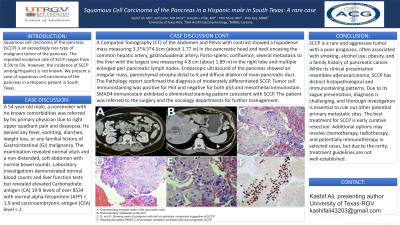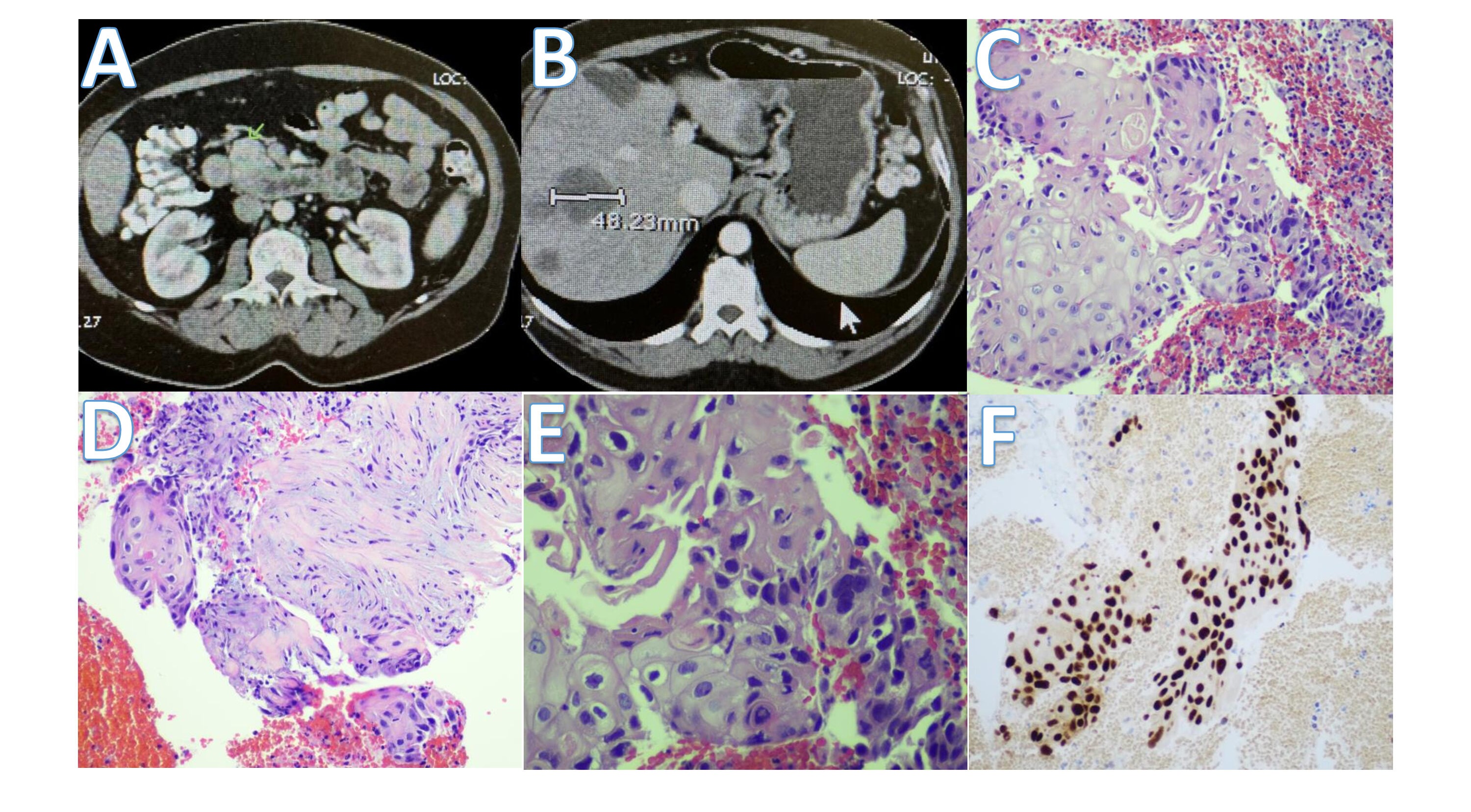Tuesday Poster Session
Category: Biliary/Pancreas
P3500 - Squamous Cell Carcinoma of the Pancreas in a Hispanic Male in South Texas: A Rare Case
Tuesday, October 29, 2024
10:30 AM - 4:00 PM ET
Location: Exhibit Hall E

Has Audio

Kashif Ali, MD
University of Texas Rio Grande Valley
Edinburg, TX
Presenting Author(s)
Kashif Ali, MD1, Asif Zamir, MD, FACG2, Sreejith J Pillai, MD3, Fnu Murk, MD4, Fnu Iqra, MBBS4
1University of Texas Rio Grande Valley, Edinburg, TX; 2Doctors Hospital at Renaissance, Edinburgh, TX; 3University of Texas Rio Grande Valley, Weslaco, TX; 4Shaheed Mohtarma Benazir Bhutto Medical University, Larkana, Sindh, Pakistan
Introduction: Squamous cell carcinoma of the pancreas (SCCP) is an exceedingly rare type of malignant tumor of the pancreas. The reported incidence rate of SCCP ranges from 0.5% to 5%. However, the incidence of SCCP among Hispanics is not known. We present a case of squamous cell carcinoma of the pancreas in a Hispanic patient in South Texas.
Case Description/Methods: A 54-year-old male, a nonsmoker with no known comorbidities was referred by his primary physician due to right upper quadrant pain and dyspepsia. He denied any fever, vomiting, diarrhea, weight loss, or any familial history of Gastrointestinal (GI) malignancy. The examination revealed normal vitals and a non-distended, soft abdomen with normal bowel sounds. Laboratory investigations demonstrated normal blood counts and liver function tests but revealed elevated Carbohydrate antigen (CA) 19-9 levels of over 8534 with normal alpha-fetoprotein (AFP) < 1.9 and carcinoembryonic antigen (CEA) level < 2. A Computed Tomography (CT) of the Abdomen and Pelvis with contrast showed a hypodense mass measuring 3.3*4.5*4.5cm (about 1.77 in) in the pancreatic head and neck encasing the common hepatic artery, gastroduodenal artery, Porto-splenic confluence, several metastasis to the liver with the largest one measuring 4.8 cm (about 1.89 in) in the right lobe and multiple enlarged peri-pancreatic lymph nodes. Endoscopic ultrasound of the pancreas showed an irregular mass, parenchymal atrophy distal to it and diffuse dilation of main pancreatic duct. The Pathology report confirmed the diagnosis of moderately differentiated SCCP. Tumor cell immunostaining was positive for P63 and negative for both p53 and mesothelial immunostain. SMAD4 immunostain exhibited a diminished staining pattern consistent with SCCP. The patient was referred to the surgery and the oncology departments for further management.
Discussion: SCCP is a rare and aggressive tumor with a poor prognosis, often associated with smoking, alcohol use, obesity, and a family history of pancreatic cancer. While its clinical presentation resembles adenocarcinoma, SCCP has distinct histopathological and immunostaining patterns. Due to its vague presentation, diagnosis is challanging and thorough investigation is essential to rule out other potential primary metastatic sites. The best treatment for SCCP is early curative resection. Additional options may involve chemotherapy, radiotherapy, and potentially immunotherapy in selected cases, but due to the rarity, treatment guidelines are not well-established.

Disclosures:
Kashif Ali, MD1, Asif Zamir, MD, FACG2, Sreejith J Pillai, MD3, Fnu Murk, MD4, Fnu Iqra, MBBS4. P3500 - Squamous Cell Carcinoma of the Pancreas in a Hispanic Male in South Texas: A Rare Case, ACG 2024 Annual Scientific Meeting Abstracts. Philadelphia, PA: American College of Gastroenterology.
1University of Texas Rio Grande Valley, Edinburg, TX; 2Doctors Hospital at Renaissance, Edinburgh, TX; 3University of Texas Rio Grande Valley, Weslaco, TX; 4Shaheed Mohtarma Benazir Bhutto Medical University, Larkana, Sindh, Pakistan
Introduction: Squamous cell carcinoma of the pancreas (SCCP) is an exceedingly rare type of malignant tumor of the pancreas. The reported incidence rate of SCCP ranges from 0.5% to 5%. However, the incidence of SCCP among Hispanics is not known. We present a case of squamous cell carcinoma of the pancreas in a Hispanic patient in South Texas.
Case Description/Methods: A 54-year-old male, a nonsmoker with no known comorbidities was referred by his primary physician due to right upper quadrant pain and dyspepsia. He denied any fever, vomiting, diarrhea, weight loss, or any familial history of Gastrointestinal (GI) malignancy. The examination revealed normal vitals and a non-distended, soft abdomen with normal bowel sounds. Laboratory investigations demonstrated normal blood counts and liver function tests but revealed elevated Carbohydrate antigen (CA) 19-9 levels of over 8534 with normal alpha-fetoprotein (AFP) < 1.9 and carcinoembryonic antigen (CEA) level < 2. A Computed Tomography (CT) of the Abdomen and Pelvis with contrast showed a hypodense mass measuring 3.3*4.5*4.5cm (about 1.77 in) in the pancreatic head and neck encasing the common hepatic artery, gastroduodenal artery, Porto-splenic confluence, several metastasis to the liver with the largest one measuring 4.8 cm (about 1.89 in) in the right lobe and multiple enlarged peri-pancreatic lymph nodes. Endoscopic ultrasound of the pancreas showed an irregular mass, parenchymal atrophy distal to it and diffuse dilation of main pancreatic duct. The Pathology report confirmed the diagnosis of moderately differentiated SCCP. Tumor cell immunostaining was positive for P63 and negative for both p53 and mesothelial immunostain. SMAD4 immunostain exhibited a diminished staining pattern consistent with SCCP. The patient was referred to the surgery and the oncology departments for further management.
Discussion: SCCP is a rare and aggressive tumor with a poor prognosis, often associated with smoking, alcohol use, obesity, and a family history of pancreatic cancer. While its clinical presentation resembles adenocarcinoma, SCCP has distinct histopathological and immunostaining patterns. Due to its vague presentation, diagnosis is challanging and thorough investigation is essential to rule out other potential primary metastatic sites. The best treatment for SCCP is early curative resection. Additional options may involve chemotherapy, radiotherapy, and potentially immunotherapy in selected cases, but due to the rarity, treatment guidelines are not well-established.

Figure: A- Demonstrating irregular mass in the pancreatic head.
B- Demonstrating metastasis to the liver.
C, D, and E- Showing nests of polygonal cells with no glandular component suggestive of SCCP.
E- Showing decreased SMAD 4 immunostain exhibition consistent with poor prognostic SCCP.
B- Demonstrating metastasis to the liver.
C, D, and E- Showing nests of polygonal cells with no glandular component suggestive of SCCP.
E- Showing decreased SMAD 4 immunostain exhibition consistent with poor prognostic SCCP.
Disclosures:
Kashif Ali indicated no relevant financial relationships.
Asif Zamir indicated no relevant financial relationships.
Sreejith J Pillai indicated no relevant financial relationships.
Fnu Murk indicated no relevant financial relationships.
Fnu Iqra indicated no relevant financial relationships.
Kashif Ali, MD1, Asif Zamir, MD, FACG2, Sreejith J Pillai, MD3, Fnu Murk, MD4, Fnu Iqra, MBBS4. P3500 - Squamous Cell Carcinoma of the Pancreas in a Hispanic Male in South Texas: A Rare Case, ACG 2024 Annual Scientific Meeting Abstracts. Philadelphia, PA: American College of Gastroenterology.
